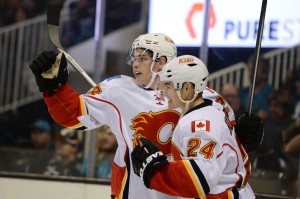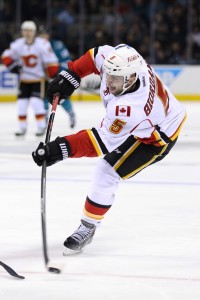The 2014-15 season went better than anybody could have realistically expected for the Calgary Flames.

Bolstered by a young, energetic team and some smart coaching decisions by Bob Hartley – along with a team that more often than not got the right bounces – the Flames made their way back to the Stanley Cup playoffs for the first time since 2009, and won a playoff series for the first time since 2004. Unlike their successful 2004 playoff run, the Flames won’t have 12 months (or a lockout) to ruminate over their season. They’ll have to get back to work right away and build upon their successes.
The big challenge? Working this offseason with an eye to the future. The club’s focus cannot be on merely making the postseason again in 2015-16; it has to be on becoming a contending team with cap space two or three seasons down the road.
THE CENTER DILEMMA
The Flames stumbled upon some good center depth this season, with sophomore Sean Monahan emerging as a top-flight pivot able to play against the best opposition in the league and not just survive, but create offense as well. He was joined by Mikael Backlund, Matt Stajan and usually some combination of Josh Jooris or Markus Granlund for the majority of the season, and that contingent was joined by 2014 fourth-overall selection Sam Bennett in the playoffs.
Long story short: for the first time since likely the early 1990s, the Flames have good center depth (and are no longer trying to find the mythical “Perfect Center To Play With Jarome Iginla”). The bad news is, because these guys are all becoming prolific, the challenge will be paying them for the long-term.
Veteran leader Matt Stajan signed a contract extension last season with a cap hit of $3.125 million. Backlund, the team’s best defensive center, is a restricted free agent (RFA) this year and will definitely get a sizable raise from this past season’s $1.5 million figure – it will probably double. That’s not bad, but consider this: following the 2015-16 season, Monahan becomes an RFA (along with winger Johnny Gaudreau), and Bennett needs a new deal following the 2016-17 season. Suddenly a very young and inexpensive group becomes much more expensive in just a few seasons.
Factor in Boston College star Bill Arnold coming off a strong first pro season with the AHL’s Adirondack Flames, while players like Drew Shore wait in the wings, and decisions will have to be made fairly quickly. Do the Flames sign Backlund long-term or for a short deal? Do the Flames try to make a move to make room for Granlund or Shore to become regular NHLers? Or does the team dig their heels in regarding their center group and try to find cap savings elsewhere?
THE DEFENSIVE CAP CRUNCH

For each of the past two seasons, Flames captain Mark Giordano has been spoken about in League circles as a Norris Trophy contender, and has quietly joined the ranks of the best defenders in the entire National Hockey League. Second-pairing defender Dennis Wideman – a power-play specialist – made more than Giordano in each of the past two seasons.
In terms of Calgary’s 2014-15 cap structure on defense, when healthy, the team looked roughly like this [contracts courtesy NHLNumbers.com]:
Mark Giordano [$4.020m] – T.J. Brodie [$2.125m]
Kris Russell [$2.6m] – Dennis Wideman [$5.25m]
Ladislav Smid [$3.5m] – Deryk Engelland [$2.917m]
In summation: Calgary’s top pairing cost $6.145 million, their second pairing cost $7.85 million, and their third pairing cost $6.417 million (yes, their bottom pair made more than their two best defenders). In a salary cap system, this is utterly insane. Granted, very little of this was general manager Brad Treliving’s doing, but it is now entirely his problem to solve. Particularly with the previously mentioned center core getting quite expensive really quickly, the Flames will need to make some cap space magically appear.
However, compounding this problem is the new deal for T.J. Brodie beginning this season with a cap hit of $4.65 million – a bargain – and Giordano’s impending contract extension, which probably should push his cap hit into the vicinity of $6 million per season (if not higher). Russell is an unrestricted free agent following 2015-16, while the expensive pacts for Engelland, Smid and Wideman are on the books until the 2016-17 season is over. Something has to give, particularly if Treliving and his management team hope to transform this mish-mashed group of defenders into something resembling that of a contending team.
THE CREASE CROWD
This past season, the Flames relied upon the two-headed monster of Karri Ramo and Jonas Hiller for steady – and occasionally very strong – goaltending. The team’s save percentage moved up from near the league’s bottom in 2013-14 to about league average in 2014-15, which is a pretty big leap for one season for a team that didn’t change its defensive group or playing style much.
Hiller has a year left on his current contract, while Ramo is a pending unrestricted free agent (UFA). Whoever remains in goal in Calgary next season will likely be joined by Finnish youngster Joni Ortio, who has made appearances in Calgary in each of the past two seasons and has paired some strong AHL numbers with flashes of brilliance in his short NHL apprenticeship. The current mindset around those following the team is that the 2015-16 goaltending tandem will probably be Hiller and Ortio, while Ramo will probably move on to another organization.
Beyond 2015-16, it’s anyone’s guess.
2014 second-round pick Mason McDonald quietly had a strong year with the QMJHL’s Charlottetown Islanders, with a save percentage ranked second in that circuit. The Flames recently signed college star (and 2012 pick) Jon Gillies, fresh off his NCAA championship win, and had him with the big club throughout their two-round playoff stint. Gillies is perhaps the team’s most exciting goaltending prospect in decades, in part because of his size and in part because of his pedigree and competitive nature. He’ll be watched closely with the new AHL affiliate in Stockton next season; with the Flames’ cap space in future seasons at a premium, going with two young (and cheap) goaltenders may be seen as a huge cost-savings opportunity. And the move would hardly be unprecedented: their divisional rivals in Anaheim cast aside Hiller themselves in favour of going with the younger and less expensive tandem of John Gibson and Frederik Andersen, using the ensuing cap space to upgrade the rest of their roster accordingly.
FOCUSING ON THE FUTURE
It’s easy to be excited because the Flames made the playoffs this past season. Their young players took big leaps forward, and the team was exciting to watch for the entire season. The key for the club, going forward, has to be building on these successes intelligently. Some strong individual contributors have undoubtedly been identified, but the challenge will be assessing which good players are indispensable pillars for the team’s future success and which are merely assets to be used to obtain other pieces of the puzzle.
It was a tremendous season in the Stampede City. But the hard work, and some very hard decisions, is only just beginning.